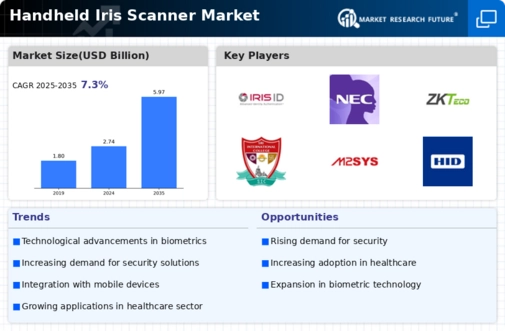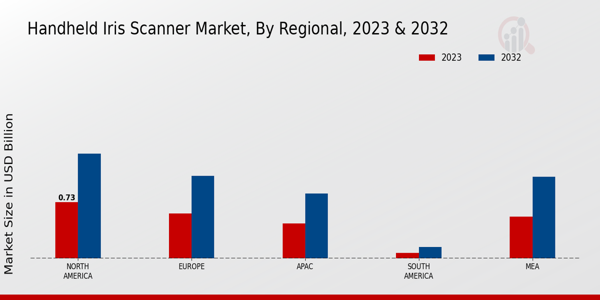Market Growth Projections
The Global Handheld Iris Scanner Market Industry is projected to experience substantial growth, with estimates indicating a market value of 2.74 USD Billion in 2024 and a remarkable increase to 5.97 USD Billion by 2035. This growth trajectory suggests a robust compound annual growth rate (CAGR) of 7.33% from 2025 to 2035. The increasing adoption of biometric solutions across various sectors, coupled with technological advancements, is likely to drive this expansion. As organizations recognize the importance of secure identification methods, the market for handheld iris scanners is poised for significant development, reflecting a broader trend towards enhanced security measures globally.
Growing Adoption in Healthcare Sector
The healthcare sector's growing adoption of handheld iris scanners significantly influences the Global Handheld Iris Scanner Market Industry. Medical facilities are increasingly utilizing iris recognition for patient identification and access control to sensitive health records. This trend is particularly relevant in environments where accurate patient identification is critical to ensuring safety and compliance with regulations. The integration of iris scanning technology enhances operational efficiency and reduces the risk of medical errors. As healthcare providers recognize the benefits of biometric solutions, the market is expected to expand, contributing to the overall growth trajectory of the industry.
Government Initiatives and Regulations
Government initiatives and regulations are instrumental in shaping the Global Handheld Iris Scanner Market Industry. Many countries are implementing stringent security measures that mandate the use of biometric identification systems in various public services. For example, national ID programs and border control policies increasingly incorporate iris scanning technology to streamline verification processes. These regulatory frameworks not only promote the adoption of handheld iris scanners but also ensure compliance with international security standards. As governments invest in advanced biometric solutions, the market is poised for growth, aligning with the projected CAGR of 7.33% from 2025 to 2035.
Increased Focus on Contactless Solutions
The Global Handheld Iris Scanner Market Industry is witnessing an increased focus on contactless solutions, driven by the need for hygiene and convenience in identification processes. Handheld iris scanners offer a non-invasive method of biometric verification, appealing to users who prioritize safety and ease of use. This trend is particularly relevant in public spaces, where minimizing physical contact is essential. As organizations seek to implement contactless identification systems, the demand for handheld iris scanners is likely to rise. This shift towards contactless technology aligns with broader consumer preferences, potentially enhancing the market's growth prospects in the coming years.
Rising Demand for Biometric Security Solutions
The Global Handheld Iris Scanner Market Industry experiences a surge in demand for biometric security solutions, driven by increasing concerns over identity theft and unauthorized access. Organizations across various sectors, including banking, healthcare, and government, are adopting iris scanning technology to enhance security protocols. This trend is evidenced by the projected market value of 2.74 USD Billion in 2024, reflecting a growing recognition of the need for reliable identification methods. As businesses prioritize safeguarding sensitive information, the adoption of handheld iris scanners is likely to expand, potentially leading to a more secure environment for both consumers and enterprises.
Technological Advancements in Iris Recognition
Technological advancements play a pivotal role in the growth of the Global Handheld Iris Scanner Market Industry. Innovations in imaging technology and artificial intelligence enhance the accuracy and speed of iris recognition systems. For instance, the integration of machine learning algorithms allows for real-time processing of iris data, significantly improving user experience. As these technologies evolve, they are expected to drive market growth, with projections indicating a market size of 5.97 USD Billion by 2035. The continuous enhancement of handheld iris scanners not only boosts their efficiency but also expands their applicability across diverse sectors, including law enforcement and border control.















